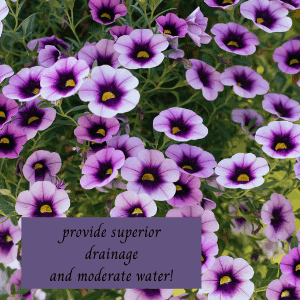“Million Bells”…but take Mark Twain’s advice
Calibrachoa (kal-ih-bru-KOE-a) is the absolutely classic version of a “spiller” plant. It may not actually have a “million bells,” but it looks like it! Think of a tumbling row of miniature petunias on your patio. This is useful for hanging baskets, window boxes, and containers. It is easy care, but moderation is something to keep in mind. Extremes, especially wet and dry, are a good way to get into trouble with this otherwise easy plant.
“Water taken in Moderation cannot hurt anybody”
-Mark Twain
Is Calibrachoa an annual? It is not a true annual that goes from seed to flower and back to seed and dies in one year. It will not survive a freeze. In our zone 10b climate, my first group of very beautiful calibrachoa hanging baskets struggled a little in our wet late summer. Please note that our garden is in South Florida, and other Zone 10 locations, Southern California and Hawaii, have less humidity.
Where Did The Name Come From?
The plant, found in South American territories in the 19th century, is named after the 19th-century Mexican Botanist Antonio de la Cal y Bracho.
Where Did The Calibrachoa Come From?
The petunia and the calibrachoa were both discovered in Brazil in the 19th century. The Petunia took off, and the rest is history. But the Calibrachoa was considered hard to grow, and gardeners ignored it until the 1990s. So it has a short history with us. It is, however, now much improved and popular, and many cultivars are being developed.
Is It A Petunia?
Originally petunia and calibrachoa were considered to be the same Genus. Now it depends on which side of the pond your garden is located. In the US, we say that they are two different genera in the Solanaceae (nightshade) family. The reason is that the two plants have different numbers of chromosomes. However, in the UK, the Royal Horticultural Society keeps them in the same Genus.
However, you classify them, these ornamental plants, petunia, calibrachoa, and their offspring, petchoa are of global importance both for the pleasure they give us and their economic benefit.
What’s The Difference-Petunia-Calibrachoa-Petchoa?
Here are three ornamental plants; two are naturally occurring, and one is a hybrid, and they are all superior performers in our gardens because of advances in biotechnology. If you do not see what you want in any one variety, keep looking. The plant breeders are producing flowers for specific situations. Check the major dealers and your best local garden centers who should be experts in your particular environment.
The Petunia is a vigorous ornamental plant in the nightshade family. It has large trumpet-shaped blossoms and is used in garden beds and in containers of all sorts. It is not the best performer in the late summer heat and in environments with heavy rains. The blossoms normally require deadheading. That having been said, this ornamental plant is so popular that you can expect constant improvements, and there are cultivars designed to address the problems. If you want the trumpet-shaped flower in a large size, only the petunia will suffice.
Calibrachoa is a naturally occurring plant that, starting in the 1990s, began to be hybridized to capitalize on its unique features. Few varieties of calibrachoa are useful planted in beds. They, however, have virtues of high volumes of flowers and unique colors that are commonly considered to be better performers than petunias in heat and rain.
The Petchoa is a man-made cultivar designed to combine the best features of each parent. They do not require pinching or pruning and have the water and heat resistance of the calibrachoa and its vivid colors.
Rabbits Will Eat Them
I have a bunch of calibrachoa plants outside, waiting for the arrival of new liners for some hanging baskets. They will hang next to a row of palm trees and add some high color behind the pool. My new plants are absolute proof that rabbits will eat Calibrachoa! Two plants, left for a short time on the ground, have been partially chewed. So up off the ground sounds like a good idea.
In our part of Florida, we have Marsh Rabbits, which are relative of the cottontail, and they are greedy. They will stand on their hind legs and pull the lowest blossoms from a weeping hibiscus, so now we know that the rabbits also like the Calibrachoa almost as well as Petunias.
Design Your Containers With Color

The color here is an important feature! The plants come in mixes in which there are blossoms of different colors on one plant. In addition, the individual blossoms themselves are multicolored,
This makes creating mixed containers a lot of fun. You can pull a color from the bell of the Calibrachoa and match it to the companion plant. So at our very good local nursery, I was able to find the Calibrachoa “Aloha Kona Hot Orange” in pinks, a little lavender, and a sort of tangerine orange and matched it to a bright tangerine Celosia. For another pot, we have Calibrocha in pink and magenta with magenta Angelonia. I can’t wait to get these pots going!
If you like fashion, design, and textiles, like me, you can get in trouble with these things.
For more information on the truly enormous range of colors in which calibrachoa are offered, read this page. (Please note that there are several pages of colors.)
Companion Plants For Calibrachoa
Companion plants, particularly in the same container, should require bright sun and well-drained soil. Here are some more ideas.
- Use the same color of calibrachoa and a larger leafed plant such as coleus or caladium for a wall of color with extra interest from texture.
- Mix with dusty miller or lambs ears; the silver colors will enhance the shades of the calibrachoa.
- Use the spires of Angelonia to add height to your containers.
- Mix bacopa with the trailing calibrachoa. The tiny white blossoms add interest, especially in the evening.
- Add height with ornamental grasses and large-leafed tropicals.
How Can We All Use The Calibrachoa?
I do think of this as a container plant, great for pots; they should look terrific in the split pots that sit on your porch railing as they will mound and trail down on both sides of the railing. As an eye-catcher for a window box or hanging basket, they will do splendidly. I am not sure how one would use them in the planting beds, although I am told that there is a variety called Garden Rose that would work. I have not seen it.
The reason is that the Calibrachoa needs the soil to dry between waterings. The Garden Rose series is bred to accept more moisture. This is one of the reasons why the moderation point is so important. They are pretty straightforward plants, but there are ways in which extremes can be deadly. The problems are extremes of wet/dry, sun/shade, and wind.
How Can We Grow It?

This is a mountainside plant from South America. Therefore, it is going to require superior drainage and, in most cases, full sun.
Planting
These plants, when sold, are often in a very root-bound condition. This leaves little soil to feed the plant. A good potting mix added to the container will be an improvement; if the roots appear bound, gently loosen them, and plant them in your container with a little time-release fertilizer, and water well. This will prevent air holes and allow the roots to make good contact with the soil that will feed them.
Light Conditions
Full sun (8 hours) in most places. In our South Florida Yard, we hang them from poles under some palm trees for moderate protection,
Soil
The soil must be well-drained, with organic matter and a pH level of 5-6.5. A high pH of extreme alkalinity would be a problem. As a container plant, use a good quality potting mix. This article discusses how to select a good quality potting mix and the features it should have.
Water
Water is a feature that must be right. You can do everything else perfectly, and if there is too much or too little water, you will fail. So this is how to do it. First, water well and wait until you can put your finger into the soil and find it dry for the top inch. Now it is time to water.
If the soil around the Calibrachoa is allowed to completely dry, the plant will stop growing and weaken. If the plant sits in water, root rot is likely to result.
“Observe good measure, moderation is best in all things.”
-Hesiod, Greek Poet
Moderation is the word for watering Calibrachoa, not wet and not dry. Hesiod was a good advisor; in 700 BC, he was considered a superior farmer. He wrote “The Works and Days,” an 800-line poem that was essentially a farmer’s almanac. It was a treatise on the virtues of a wise farmer and written to his ne-er- do- well brother! The brother sounds like a character from a Mark Twain novel!
People have been gardening and writing about it for a long time. So glad I don’t have to do it in verse.
Fertilizer
Calibrachoa is a very fast growing plant, this makes it a heavy feeder. Start the plants with a timed-release fertilizer, and supplement with liquid fertilizer for blooming plants on a weekly basis. I just add the feeder to the garden hose and combine it with one watering. A fertilizer with chelated iron will ensure bright green foliage.
Trimming and Pruning
As the season progresses you will notice that the very bottoms of the plant may look less bountiful. When this happens trim the ends below the pot with scissors. This will encourage new growth and extend the life of the plants.
Pests And Diseases
Pests
Tobacco budworms also called geranium budworms will cause irregular or round holes in foliage. Look for a caterpillar with longitudinal white stripes. Look for caterpillars and remove them and any damaged plant material. You can use a residual insecticide. Here is a good piece on budworms from the University of Minnesota.
Aphids are a problem to look for on a regular basis. Look for colonies on the underside of leaves, They are tiny, greenish and multiply fast! You will see yellowed and distorted foliage. Wash them off with a spray of water, insecticidal soap, or neem oil.
Diseases
Powdery Mildew-look for white powdery fungal growth on foliage. There will sometimes be leaf discoloration and leaf drop. The damage often begins on lower foliage and is easy to overlook. Treat with a fungicide labeled for powdery mildew.
A Small Update
My new hanging basket liners just arrived, and I potted the 4 Calibrachoa hanging baskets. The plants we bought were of a good size (3 plants filled 14″ hanging baskets. They were a little root bound, having extensive white root systems. I gently loosened the roots while planting them. The potting soil is used and sold by a local wholesale grower who produced the plants. I artfully arranged the rabbit chewed parts and hung them where even Harvey won’t reach them.
The calibrachoa baskets lasted from early spring to very late summer. Our extreme heat, humidity, and heavy rainstorms eventually won but we had a great run with the plants. We will keep using them.
